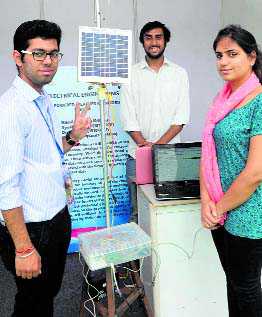Tribune News Service
Chandigarh, April 18
To offer the world an insight into the work undertaken by their students, the PEC University of Technology organised a two-day event, Open House-2017, which started here today. It is an annual exhibition of innovative projects designed by PEC students.
Started with an aim to create more awareness about science and its impact among the general public, the event has drawn ever increasing crowds with each passing year. And this year was no exception.
For Day 1, students from all years and branches displayed their path-breaking innovations such as self-balancing robot, home physiotherapy, solar-powered weather monitoring system and crop monitoring using drones.
Expert panellists - Renu Vig, Director, UIET; KK Vohra, President, PECOSA; and Lalit Singla, Senior Project Manager, Infosys Limited, examined the projects.
After the evaluation of the projects, Rs 5,000, Rs 3,000, Rs 2,000 and Rs 1,000 each were given away to the first, second, third and consolation prize winners, respectively.
The first prize was bagged by the project “women security assistance system with GPS tracking and messaging system”; the second prize was won by “parallel operation using PLC”, and the third prize was bagged by “crop health monitoring using drones”. Consolation prizes were given to “regenerative portable in-room AC” and “human fall detection system with IMU sensors”.
Solar-powered weather station
Designed by students of the electrical engineering department – Nikhil Arora, Vyushti Daftari, Disha Chugh and Piyush Mantani – it can help predict water and fodder requirements of farmers for their crops and livestock. The station has various sensors attached that can measure air pressure, temperature, humidity, wind direction and speed besides rainfall. These sense the atmospheric data and save it on a web server at regular intervals. “All data is saved with the timestamp with it so that it is easy to analyse it,” informed Disha. Piyush added that this sensed data is useful for prediction of further conditions locally to the industry so that the concerned people can take protective measures before anything happens. “Our target clientele is state agriculture universities as this weather station works best for large farms,” informed Nikhil, adding that the product can help make industries self-sufficient. The students informed that the market price of the product is Rs 50,000 but their product would cost Rs 12,000.
Disease prediction system
Designed by Prathamesh, Jashanjot Kaur, Ashish Mishra and Swati Nanda, final-year students of computer science and engineering, the disease prediction system is aimed at early cancer detection. “Identification of genetic and environmental factors is very important in developing novel methods to detect and prevent cancer. Therefore, a novel clustering technique is used to build a cancer risk prediction system,” informed Swati. Jashanjot added, “The project uses intensive data mining techniques applied on medical records available online. K-Nearest Neighbour algorithm is being used for training the classifier and classifying the cancer into benign and malignant. This classifier will then be used to predict any new case of cancers.” “If implemented successfully, this classifier system can be extensively employed in medical field by cancer specialists, increasing precision and accuracy of detection,” said Prathamesh.
Women security assistance system
Designed by Amit Verma, Aditya Goyal and Vineet Jain, students of electronics and communication engineering, the device is a technological solution to women’s safety. Costing Rs 1,000, the device can connect a person in distress with his/her contacts in the need of the hour. Amit explains, “The project consists of 2 Arduino microcontrollers, GSM, LCD, keypad, GPS, RTC, micro SD card module, active and panic buttons.” Vineet adds, “On pressing the active button, the devise will send information regarding the user’s last location to these numbers in the form of an SMS.” “When panic button is pressed, another SMS will be sent, showing emergency and current location of the user, which can be easily tracked by Google maps,” informed Aditya.
Unlock Exclusive Insights with The Tribune Premium
Take your experience further with Premium access.
Thought-provoking Opinions, Expert Analysis, In-depth Insights and other Member Only Benefits
Already a Member? Sign In Now










